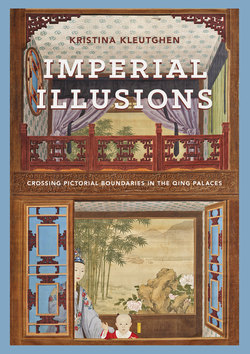Читать книгу Imperial Illusions - Kristina Kleutghen - Страница 66
На сайте Литреса книга снята с продажи.
Оглавлениеskills rather than signs of true artistic ability, then the generally dismissive response of the literati to European works becomes even less surprising.
However, even Zou grudgingly admitted that the paintings of architectural spaces that the Western artists produced on walls were deceptive enough to make the viewer almost want to step inside. By 1756 he would certainly have seen enough scenic illusion paintings to have experienced their illusions firsthand. The fact that he specifies the subject and the painting surface in this comment is also an important indication of the presence of such works and the visual success of their illusionism in the Qing imperial milieu. Sir John Barrow also noted this in the responses of several Qing court officials to an illusionistic painting in the Perfect Brightness Garden at the end of the eighteenth century: “Gherardini painted a large colonnade in vanishing perspective, which struck [the officials] so very forcibly that they concluded he must certainly have dealings with the devil; but, on approaching the canvas and feeling with their hands, in order to be fully convinced that all they saw was on a flat surface, they persisted that nothing could be more unnatural than to represent distances where there actually neither was, nor could be, any distance.”102 In addition to providing very rare evidence of nonimperial reception of scenic illusions in the palaces, Barrow here identifies a now-lost scenic illusion installed in the primary imperial garden residence. Given Gherardini’s brief stay at the Kangxi court, the later development of scenic illusions, and the fact that Yongzheng and Qianlong (not Kangxi) developed the Perfect Brightness Garden, Barrow’s painting was more likely a later work produced on silk by the Wish-Fulfilling Studio painters.
The effects of pictorial illusionism may have unsettled Qianlong’s officials, who otherwise likely thought themselves sophisticated viewers, but Qianlong proved himself to be the superior viewer because he could enjoy the ability of European illusionistic painting techniques to deceive him into briefly seeing something other than what was actually there. Although all painting styles are two-dimensional, some—as in the literati definition of Chinese painting—draw attention to or do not try to disguise their flatness and the importance of human creative agency. Even paintings historically considered to be successfully illusionistic, such as Wu Daozi’s, often used plainly visible brush lines. But it was the lively quality of these lines or the visible presence of the artist’s personality that animated the paintings. In contrast, the European tradition of pictorial illusionism deliberately attempted to conceal the flatness of the painting surface, the hand of the artist, and the materiality of the work. Illusionistic painting can exist in any medium and on any surface, but the large, flat surfaces of walls historically offered the greatest potential for a long-lasting illusion that encompassed the viewer’s entire visual field and briefly deceived him into thinking that what he saw was real. It is this ability to understand and enjoy both the reality and the illusion simultaneously, and to delight in one’s misperception rather than be troubled by it, that enables the fullest appreciation of scenic illusion paintings.
The centuries of adverse criticism of pictorial illusionism and the decline and loss of illusionistic murals seem to have resulted in art-historical amnesia regarding the presence
